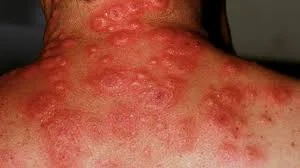Etiology of Sweet Syndrome
Sweet syndrome (acute febrile neutrophilic dermatosis) has numerous potential causes, categorized by subtype:
1. Classic or Idiopathic Sweet Syndrome
The most common type, accounting for 71% of cases, typically occurs without a clear underlying condition. Approximately 2% of cases are linked to pregnancy.
2. Malignancy-Associated Sweet Syndrome
Hematologic cancers (especially acute myeloid leukemia) are most frequently linked to Sweet syndrome. Other malignancies include myelodysplasia, chronic myelogenous leukemia, and nonmyeloid cancers like genitourinary, breast, and gastrointestinal tumors.
3. Infection-Related Sweet Syndrome
Bacterial infections (e.g., Streptococcus pneumoniae, Staphylococcus, Salmonella), fungal infections (e.g., coccidioidomycosis), and viral infections (HIV, hepatitis, CMV) have been associated with the syndrome.
4. Drug-Induced Sweet Syndrome
Medications such as G-CSF, all-trans retinoic acid (ATRA), and trimethoprim-sulfamethoxazole are well-established causes. Many other drugs, including antibiotics, immunosuppressants, and vaccines, have also been implicated.
5. Systemic Disorder-Related Sweet Syndrome
Inflammatory diseases like Crohn’s disease, ulcerative
colitis, Sjögren's syndrome, lupus, and rheumatoid arthritis are linked to
Sweet syndrome, accounting for about 16% of cases.
6. Miscellaneous Causes
Sweet syndrome has been reported in rare cases following surgery, in transplant patients, and as part of immune reconstitution inflammatory syndrome (IRIS) in HIV patients. Radiotherapy has also been implicated.
Epidemiology of Sweet Syndrome
Frequency: Sweet syndrome is uncommon but not rare. About 10-20% of cases are linked to malignancies, though most cases are idiopathic or associated with benign conditions.
Race: There is no known racial predilection.
Sex:
- Classic/Idiopathic Sweet Syndrome: Predominantly affects females, with a female-to-male ratio of 3:1 to 8:1.
- Drug-Induced Sweet Syndrome: Also shows a female predominance.
- Malignancy-Associated Sweet Syndrome: No sex predilection.
- Children: No sex predilection is observed.
Age:
·
Most commonly occurs in
women aged 30-50.
· Rare in children, often associated with infection or, in some cases, malignancy. Cases in neonates as young as 5 days have been reported.
Prognosis of Sweet Syndrome
Most cases of Sweet syndrome resolve, though some can persist, leading to pain and skin breakdown. The prognosis is heavily influenced by the underlying cause, particularly in cases associated with malignancies or drug reactions. Recurrence occurs in up to 50% of patients, particularly in those with hematologic malignancies.
Clinical History
Typically, fever precedes the skin lesions by days to weeks, though they can also appear simultaneously. Many patients report a recent upper respiratory infection, tonsillitis, or flu-like illness 1-3 weeks before the onset of skin lesions. Recent vaccination or gastrointestinal infection may also precede eruptions. The lesions, which often appear abruptly, can last from days to months if untreated.
Physical Examination of Sweet Syndrome
Cutaneous Manifestations:
· Lesions: Bright-red, reddish-blue, or violet papules, plaques, or nodules, sometimes appearing vesicular due to subepidermal edema. Pustules may stud these lesions, which often coalesce into circinate or arcuate plaques.
· Location: Commonly affect the face, neck, and extremities in an asymmetric pattern. Atypical presentations may involve the auditory canal or scalp, and ulcerative or bullous lesions are more common in malignancy-related Sweet syndrome.
· Characteristics: Lesions are painful, burning, but not pruritic, and resolve without scarring.
· Specific Sites:
§ Hands: Lesions may be symmetrically distributed on the dorsal
aspects of the fingers and hands.
§ Oral/Ocular Mucosa: Oral lesions (on lips, buccal mucosa,
tongue) are common in hematologic disorders. Ocular manifestations include
conjunctivitis, episcleritis, uveitis, and other forms of eye inflammation.
Outside the Skin:
· Lungs: It can cause shortness of breath, a chronic cough, fluid in the lungs, or other breathing issues. In severe cases, it might lead to respiratory failure but usually improves with steroid treatment.
· Kidneys: It may cause problems like protein or blood in the urine, or a drop in creatinine levels.
· Central Nervous System (CNS): In 69 cases, it affected the brain and nerves, leading to symptoms like inflammation of the brain (encephalitis), meningitis, headaches, confusion, and seizures. There may be a genetic link (HLA-B54 and HLA-CW1) to CNS-related Sweet Syndrome. Other issues like nerve damage and changes in spinal fluid have also been seen.
· Other Organs: It can also affect bones, the digestive system, joints, liver, heart, muscles, and spleen. In rare cases, it can progress to a serious condition called Systemic Inflammatory Response Syndrome (SIRS), which can lead to organ failure and shock.
Reaction to Injury:
· Lesions: Small sores can form at sites of minor injury, similar to a condition called pyoderma gangrenosum.
Underlying Conditions & Pregnancy: Sweet Syndrome can be linked to other diseases like cancer or systemic issues. Imaging tests may be needed to figure out the cause. During pregnancy, the condition might come back in later pregnancies but doesn’t usually harm the baby.









No comments:
Post a Comment